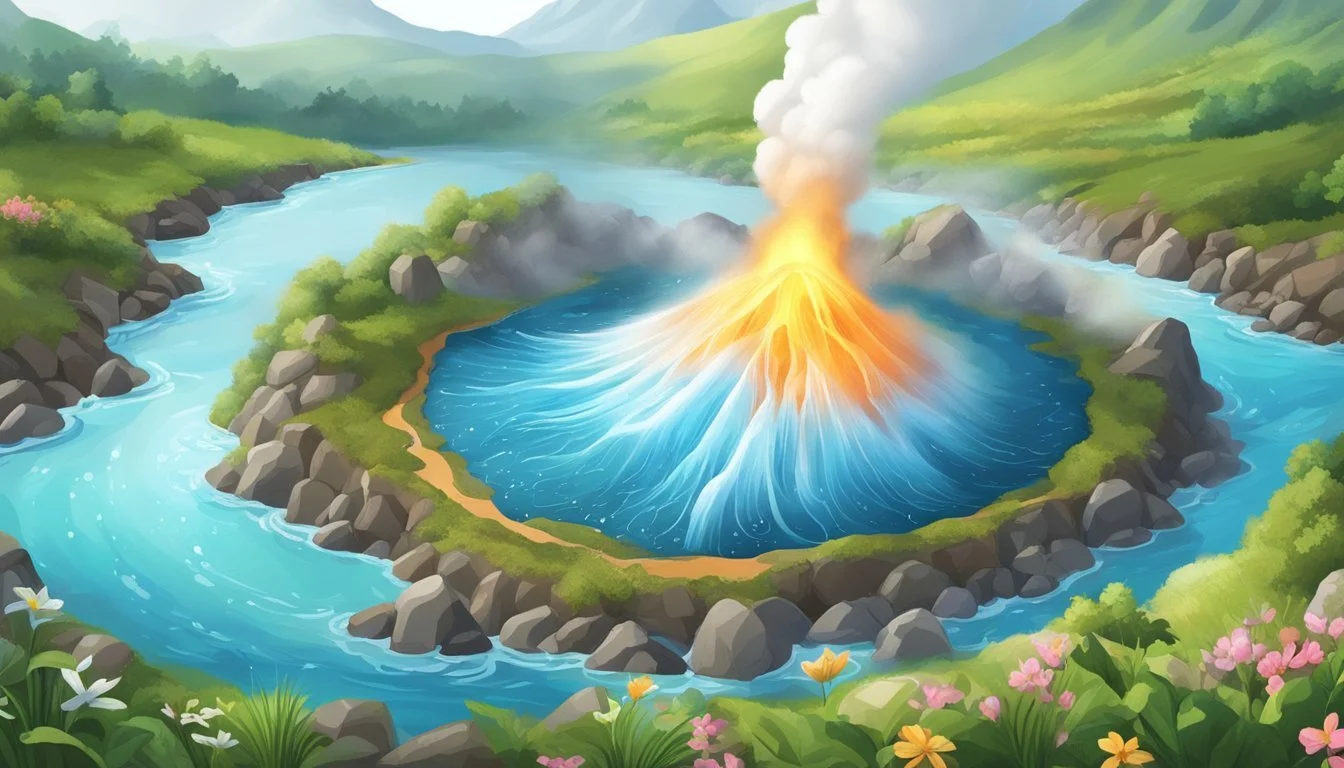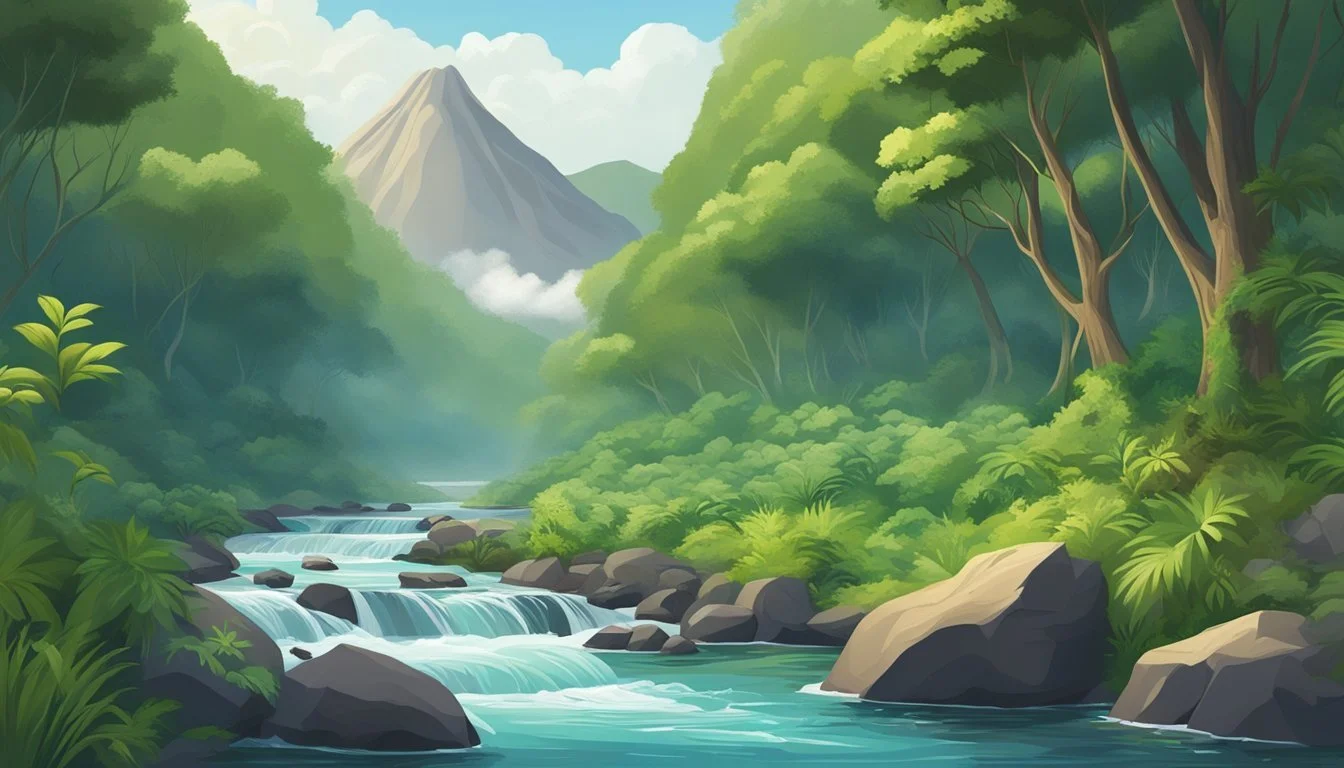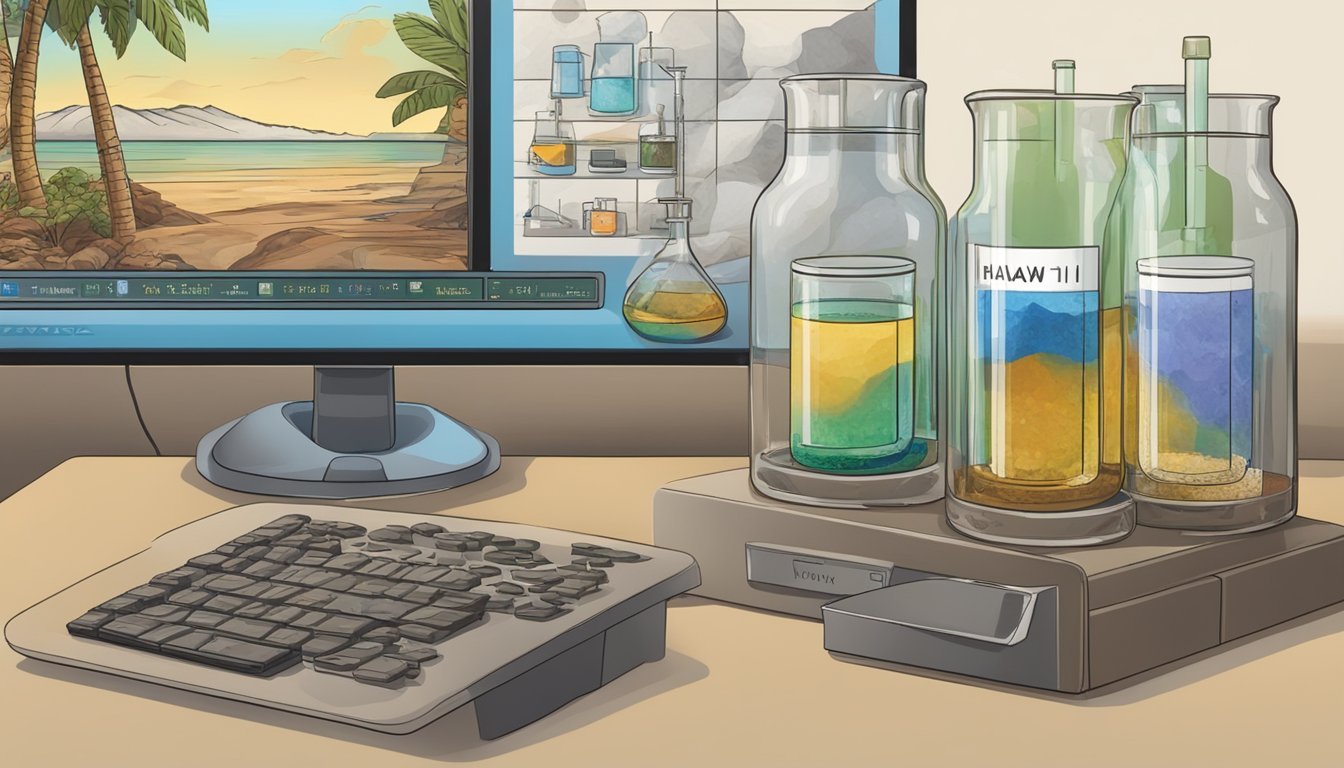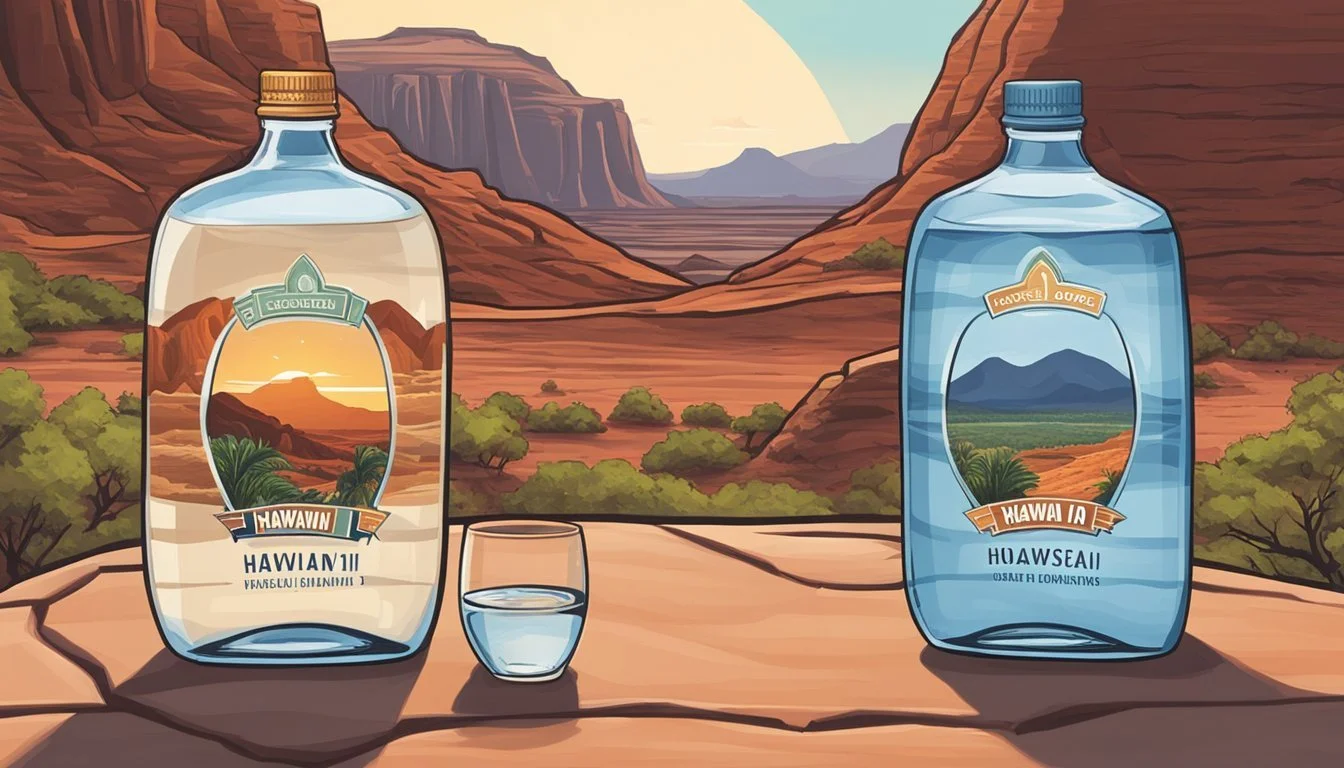Hawai’i Volcanic vs. Purely Sedona
Which Bottled Water is Better?
Choosing between Hawai’i Volcanic and Purely Sedona often comes down to personal preferences and priorities. Both bottled water brands offer unique characteristics when it comes to taste, health benefits, and sustainability. Hawai’i Volcanic is renowned for its low total dissolved solids (TDS) of about 40 ppm, and a slightly acidic pH of around 5, providing a crisp and clean taste.
Purely Sedona, bottled by Sedona Bottling Company, also presents an acidic profile in its sparkling variant. While both waters are relatively similar in their pH levels, they each have distinct sourcing and branding that may influence consumer choice. The smooth texture and understated mineral presence make Purely Sedona a notable contender.
When it comes to sustainability, Waiakea, the company behind Hawai’i Volcanic, stands out. They emphasize a commitment to environmental responsibility, being the first US bottled water certified Carbon Neutral and dedicating over 5% of their revenue to global nonprofit efforts. This strong focus on sustainability may tilt the scale in favor of Hawai’i Volcanic for eco-conscious consumers.
The Significance of pH in Bottled Water
The pH level of bottled water plays a crucial role in determining the water's acidity or alkalinity, which can have significant health implications. Understanding pH levels, the difference between alkaline and acidic water, and the impact on health is essential when choosing the right bottled water.
Understanding pH Levels
pH is a scale that measures how acidic or alkaline a substance is, ranging from 0 to 14. A pH of 7 is neutral, meaning it is neither acidic nor alkaline. Values below 7 indicate acidity, while values above 7 indicate alkalinity.
Bottled waters like Waiākea offer a naturally alkaline pH range around 7.6 to 8.2. This is notable because most bottled waters typically have pH levels between 5 and 7.
Alkaline vs. Acidic Water
Alkaline water has a pH level above 7. Purely Sedona, for example, often aims for a higher pH to offer various health benefits. In contrast, acidic water has a pH level below 7.
Alkaline water is believed to neutralize the acidity in the body. Acidic water can sometimes cause issues like erosion of tooth enamel. Consumers often seek alkaline water for its potential benefits in this regard.
Health Implications of pH
The pH level of water is thought to influence health in several ways. Alkaline water with a high pH can help to neutralize stomach acid, potentially aiding in acid reflux conditions. It is also suggested to support metabolism and hydration more effectively than neutral or acidic water.
Conversely, highly acidic water might not be ideal for regular consumption. It could exacerbate issues such as acid reflux and have less favorable effects on dental health. As such, understanding pH can guide better choices in bottled water for health benefits.
Source and Natural Filtration
Hawai’i Volcanic and Purely Sedona both source their water from unique and natural origins. These sources influence the filtration process and the mineral content of the water.
Hawaiian Volcanic Water Sources
Hawaiian Volcanic Water™ originates from the eastern base of the Mauna Loa volcano in Hilo, Hawai’i. The water is captured as it filters through 14,000 feet of porous volcanic rock, resulting in natural filtration.
The rainwater begins its journey atop the Mauna Loa volcano, an area devoid of industrial contaminants due to its remote location. This filtration process enriches the water with minerals like silica, aiding in bone and skin health.
Sedona's Water Sourcing
Purely Sedona is sourced from natural aquifers located in the region of Sedona, Arizona. These aquifers are deep underground and are replenished by rainfall and snowmelt that seep into the earth.
The water travels through several layers of rock and sand, which naturally filter out impurities. The aquifer system in Sedona is known for its mineral-rich composition, primarily characterized by its profound alkaline content and soft, smooth taste.
Volcanic vs. Aquifer Filtration
The primary difference between volcanic and aquifer filtration lies in the natural materials the water interacts with. Hawaiian Volcanic Water™ passes through extensive layers of porous volcanic rock, a process that enhances purity and mineral content such as electrolytes.
In contrast, Sedona’s aquifer water filters through sedimentary rock and sand, providing a different mineral profile. While both natural filtrations are effective, volcanic rock often results in a higher level of silica, whereas aquifers typically contribute a broader spectrum of minerals.
By comparing the volcanic filtration at Mauna Loa and Sedona's aquifer system, consumers can appreciate the unique qualities each water source brings to the bottle.
Mineral Content Analysis
This section will compare the essential minerals for hydration found in Hawai’i Volcanic and Purely Sedona waters, analyze their comparative mineral content, and review their total dissolved solids (TDS).
Essential Minerals for Hydration
Calcium and Magnesium are crucial for hydration. Hawai’i Volcanic water contains a significant amount of these electrolytes, sourced naturally from volcanic rocks. These minerals help support bone health, muscle function, and metabolic activity.
Purely Sedona water also includes essential minerals but in varying quantities. Key electrolytes, including Potassium and Sodium, are often found in both brands, helping to maintain fluid balance and nerve function.
Both waters aim to provide a healthy mix of minerals that are beneficial for daily hydration needs.
Comparative Mineralogy
Hawai’i Volcanic water and Purely Sedona water differ in their mineral profiles. Hawai’i Volcanic water has Silica, known for its benefits to skin, hair, nails, and collagen synthesis. This water also includes Electrolytes like magnesium and potassium, enhancing hydration and bodily functions.
Purely Sedona sparkling water has a different mineral composition. It is rich in Sodium, which can be important for nerve and muscle function.
Comparing both, Hawai’i Volcanic water stands out due to its natural filtration through lava, enriching it with a unique mineral mix, whereas Purely Sedona offers a robust presence of sodium and other basic electrolytes.
Total Dissolved Solids
Total Dissolved Solids (TDS) is a measure of all minerals and impurities in water. Hawai’i Volcanic water has a TDS of approximately 40 ppm, indicating a lower concentration of minerals. This makes it a lighter choice but still sufficient for basic hydration needs.
Purely Sedona water typically shows similar TDS levels for its sparkling variants. This figure signifies that the water is not heavily mineralized, which can appeal to those seeking a clean, crisp taste without excess mineral content.
Both brands provide quality options with different TDS levels, catering to varied preferences.
Health and Hydration
Staying hydrated is essential for overall health, promoting bodily functions, and enhancing physical and cognitive performance. This importance is reinforced through optimal hydration strategies, especially tailored for athletes and daily needs.
Benefits of Hydration
Hydration is crucial for maintaining the body's temperature regulation, joint lubrication, and nutrient transportation. Proper hydration supports digestion, skin health, and cognitive function. Drinking water, like Hawai’i Volcanic and Purely Sedona, can help achieve these benefits.
Both brands offer naturally filtered water, rich in minerals due to volcanic and sedimentary filtration processes, respectively. They boast mineral compositions that contribute to balanced electrolytes, essential for maintaining the body’s fluid balance.
Optimal Hydration for Athletes
Athletes have higher hydration needs due to increased fluid loss from sweat during intensive physical activities. Consuming water that replenishes lost minerals like magnesium, calcium, and potassium is vital. Hawai’i Volcanic, with its natural volcanic filtration, provides a mineral-rich option that caters to these needs.
Purely Sedona, sourced from artesian wells, also offers a mineral content beneficial for recovery and performance. Both brands aid in reducing fatigue, preventing cramps, and sustaining endurance levels essential for athletic performance.
Hydration and Daily Intake
Meeting the recommended daily intake (RDI) of water helps in maintaining overall health. The RDI generally varies depending on factors such as age, sex, and activity level. For adults, it's suggested to drink about 2-3 liters per day.
Hawai’i Volcanic and Purely Sedona provide clean and naturally sourced options that can encourage regular consumption. Regular intake of these waters ensures sufficient hydration to support metabolic processes, toxin elimination, and energy levels throughout the day.
Incorporating these brands into daily routines can make adhering to water intake recommendations easier and more enjoyable.
Environmental Impact and Sustainability
Environmental impact and sustainability are critical when comparing bottled water brands. Key considerations include plastic use and recycling initiatives, sustainable sourcing, and environmental conservation efforts.
Plastic Use and Recycling Initiatives
Hawai’i Volcanic focuses on reducing plastic waste by using RPET (recycled polyethylene terephthalate) for its bottles. This material is more sustainable than traditional plastics, as it reuses existing plastic and lessens the demand for new production. Moreover, their bottles are also BPA-free, which is safer for consumers' health.
Purely Sedona, however, takes a different approach. They prioritize minimal waste by offering glass bottled options in addition to plastic ones. This not only reduces plastic pollution but also encourages consumers to reuse and recycle the bottles. Both brands encourage recycling through partnerships and educational campaigns, making significant strides in creating a more sustainable product lifecycle.
Sustainable Sourcing Practices
The sustainability of water sourcing practices varies between these two brands. Hawai’i Volcanic sources its water from snowmelt and rain atop the Mauna Loa Volcano, ensuring a natural and renewable water source. The process harnesses the natural filtration of volcanic rock, contributing to the water's purity and mineral content.
Purely Sedona sources its water from artesian wells in Arizona. These wells are fed by natural springs, but the company has faced criticisms for potential over-extraction. They claim to monitor and manage their water extraction carefully to avoid depleting local resources, striving for a balance between high-quality water production and environmental responsibility.
Environmental Conservation Efforts
Both companies engage in conservation efforts but focus on different areas. Hawai’i Volcanic collaborates with organizations like Pump Aid to provide clean water solutions in regions like Malawi, Africa. Their contributions include infrastructure improvements and creating educational opportunities about water sustainability.
Purely Sedona, on the other hand, channels efforts into local conservation projects in Arizona. These initiatives include habitat restoration and sponsoring community clean-up events. They aim to preserve the natural beauty and resources of their surrounding environment, ensuring that their business operations do not compromise the ecological balance.
By investing in both global partnerships and local projects, both brands demonstrate a commitment to reducing their environmental footprint and promoting sustainable practices. These efforts are critical for customers who prioritize environmental responsibility in their purchasing decisions.
Taste Profile
The flavor of bottled water can vary significantly between brands due to factors such as mineral content and individual taste perceptions. Hawai’i Volcanic and Purely Sedona each offer unique taste experiences.
Subjective Nature of Taste
People's tastes differ greatly, making bottle water flavor a personal experience. Hawai'i Volcanic is often described as smooth and slightly sweet, appealing to those who prefer a subtle mineral taste.
In contrast, Purely Sedona offers a crisper, cleaner flavor, with a neutral profile that some may find more refreshing. Taste preferences may be influenced by familiarity and individual palate sensitivity.
Influence of Minerals on Taste
Mineral content plays a crucial role in the taste of bottled water. Hawai’i Volcanic contains minerals from its volcanic source, contributing to its distinct, slightly sweet flavor. The presence of essential minerals like magnesium and calcium can enhance its smoothness.
Purely Sedona, sourced from artesian springs, has a balanced mineral composition. This balance results in a clean and pure taste with minimal aftertaste, making it suitable for those who prefer a more neutral flavor profile. The mineral makeup not only affects taste but also the water's overall mouthfeel.
Economic Factors and Brand Comparison
Hawai'i Volcanic and Purely Sedona are two premium bottled water brands. This section explores their cost implications and market positions.
Cost Analysis
The costs associated with premium bottled water can significantly influence consumer choices. Hawai'i Volcanic bottles are often priced higher due to their sourcing from volcanic springs, marketing as natural and alkaline water, and limited distribution.
Purely Sedona, while still positioned as a premium brand, tends to be more competitively priced. Its sourcing from artisan wells and regional marketing strategies help manage production costs.
Fiji Water, for a broader market comparison, is another high-end brand, often carrying premium prices linked to its distinctive taste and Fiji origin.
Consumers might find Icelandic Glacial equally expensive due to its claimed purity and minimal processing.
Brand Value and Market Position
Hawai'i Volcanic leverages its unique volcanic filtration and environmental commitment to stand out. Marketing emphasizes sustainability, natural benefits, and exclusive Hawaiian source, all of which add to its luxury image and ability to command higher prices.
Purely Sedona differentiates itself with its focus on purity and local sourcing from Sedona's artesian wells. This gives it a strong regional presence, though perhaps less international recognition compared to Hawai'i Volcanic.
In a broader context, Evian and Essentia are strong market players due to their established reputations and wide availability in various retail channels including Whole Foods.
Both Fiji and Icelandic Glacial maintain premium market position through distinctive branding and specific origin selling points.
Overall, the decision between Hawai'i Volcanic and Purely Sedona may hinge on specific consumer preferences regarding brand values and economic considerations.
Packaging and Accessibility
Understanding the packaging materials and market availability can greatly impact a consumer's choice between Hawai’i Volcanic and Purely Sedona. This section will explore the differences in bottle materials, market availability, and the options for subscription services for each brand.
Bottle Materials and Consumer Health
Hawai’i Volcanic bottles are crafted from 100% RPET (recycled polyethylene terephthalate), ensuring they are BPA-free and environmentally friendly. The company emphasizes the importance of using sustainable materials to reduce environmental impact and protect consumer health.
Purely Sedona offers its water in aluminum bottles, which are also BPA-free. Aluminum is praised for being highly recyclable and durable, adding another layer of sustainability. Customers often appreciate this choice due to aluminum's ability to keep the water cooler for longer periods.
Comparison Table:
Feature Hawai’i Volcanic Purely Sedona Bottle Material 100% RPET Aluminum BPA-Free Yes Yes Recyclable Highly Highly Consumer Health Emphasized Emphasized
Market Availability
Hawai’i Volcanic has a robust market presence, particularly in health food stores and premium grocery chains. It is also available through various online platforms, making it accessible to a wide range of consumers both locally and internationally.
Purely Sedona is primarily found in upscale supermarkets and boutique health shops. While its market reach isn't as extensive as Hawai’i Volcanic, it is gaining popularity due to its premium packaging and taste profile. Online purchasing options are available but somewhat limited compared to Hawai’i Volcanic.
Store Options Breakdown:
Hawai’i Volcanic: Widespread in health food stores, premium grocery chains, online.
Purely Sedona: Upscale supermarkets, boutique health shops, select online platforms.
Subscription Services
Hawai’i Volcanic offers a comprehensive subscription service, allowing consumers to receive regular deliveries. Subscribers can choose the frequency and volume of their orders, benefiting from discounts and exclusive deals.
Purely Sedona also provides subscription plans, though they are more limited in scope. Subscribers can select specific delivery schedules but might not have as many customization options as Hawai’i Volcanic. The service includes some incentives like reduced prices and occasional promotional offers.
Key Subscription Features:
Hawai’i Volcanic: Flexible frequency, volume choices, exclusive discounts.
Purely Sedona: Standard delivery schedules, price reductions, promotional offers.
Final Verdict
Hawai’i Volcanic and Purely Sedona are both marketed as premium water brands. Each offers distinct benefits and characteristics.
Hawai’i Volcanic
Source: Eastern base of Mauna Loa volcano, Hilo, Hawai'i.
pH Level: Ranges from 7.6 to 8.5.
Key Benefits: Natural electrolytes, high alkalinity, pure volcanic filtration.
Purely Sedona
Source: Natural artesian springs, Sedona, Arizona.
pH Level: Typically around 7.5 to 7.7.
Key Benefits: Natural minerals, artesian spring purity, smooth taste.
Healthy Hydration
Both brands emphasize healthy hydration. Hawai’i Volcanic focuses on alkalinity which can help neutralize body acidity. Purely Sedona highlights natural artesian water benefits.
Premium Water
In terms of premium quality:
Hawai’i Volcanic: Considered for its volcanic source and deep well extraction.
Purely Sedona: Known for the pristine Sedona artesian springs.
Taste and Packaging
Hawai’i Volcanic: Often described as crisp and refreshing. Eco-friendly packaging. Purely Sedona: Praised for its smooth taste and natural essence. Traditional premium packaging.
Choosing between Hawai’i Volcanic and Purely Sedona depends on personal preference for taste, the importance of alkaline water, and the source of the water. Both options provide high-quality hydration and cater to the premium water market.
More About Hawai’i Volcanic
Acqua Pana vs Hawaii Volcanic: Which Bottled Water is Better?
Antipodes vs Hawaii Volcanic: Which Bottled Water is Better?
Aqua Carpatica vs Hawaii Volcanic: Which Bottled Water is Better?
Arrowhead vs Hawaii Volcanic: Which Bottled Water is Better?
Boxed Water vs Hawaii Volcanic: Which Bottled Water is Better?
Castle Rock vs Hawaii Volcanic: Which Bottled Water is Better?
Core Hydration vs Hawaii Volcanic: Which Bottled Water is Better?
Deer Park vs Hawaii Volcanic: Which Bottled Water is Better?
Hawaii Volcanic vs 1907water: Which Bottled Water is Better?
Hawaii Volcanic vs Alkaline88: Which Bottled Water is Better?
Hawaii Volcanic vs Big Chill: Which Bottled Water is Better?
Hawaii Volcanic vs BodyArmor: Which Bottled Water is Better?
Hawaii Volcanic vs Cascade Mountain: Which Bottled Water is Better?
Hawaii Volcanic vs CBD Living: Which Bottled Water is Better?
Hawaii Volcanic vs Crystal Geyser: Which Bottled Water is Better?
Hawaii Volcanic vs Crystal Lake: Which Bottled Water is Better?
Hawaii Volcanic vs Essence pH10: Which Bottled Water is Better?
Hawaii Volcanic vs Kirkland Signature: Which Bottled Water is Better?
Hawaii Volcanic vs Liquid Death: Which Bottled Water is Better?
Hawaii Volcanic vs Open Water: Which Bottled Water is Better?
Hawaii Volcanic vs Proud Source: Which Bottled Water is Better?
Hawaii Volcanic vs Pure Life: Which Bottled Water is Better?
Hawaii Volcanic vs Richard's Rainwater: Which Bottled Water is Better?
Hawaii Volcanic vs Simple Truth: Which Bottled Water is Better?
Hawaii Volcanic vs Talking Rain AQA: Which Bottled Water is Better?
Hawaii Volcanic vs Weird Water: Which Bottled Water is Better?
Hawaii Volcanic vs Whole Foods 365: Which Bottled Water is Better?
Hawaii Volcanic vs Whole Foods Italian Still Mineral water: Which Bottled Water is Better?
Hawaiian Springs vs Hawaii Volcanic: Which Bottled Water is Better?
Ice Mountain vs Hawaii Volcanic: Which Bottled Water is Better?
Icelandic Glacial vs Hawaii Volcanic: Which Bottled Water is Better?
Just Water vs Hawaii Volcanic: Which Bottled Water is Better?
Mountain Valley Spring Water vs Hawaii Volcanic: Which Bottled Water is Better?
Nestle Pure Life vs Hawaii Volcanic: Which Bottled Water is Better?
Poland Spring vs Hawaii Volcanic: Which Bottled Water is Better?
San Pellegrino vs Hawaii Volcanic: Which Bottled Water is Better?
Smartwater vs Hawaii Volcanic: Which Bottled Water is Better?
Solan de Cabras vs Hawaii Volcanic: Which Bottled Water is Better?
Topo Chico vs Hawaii Volcanic: Which Bottled Water is Better?
Zephyrhills vs Hawaii Volcanic: Which Bottled Water is Better?
More About Purely Sedona
Aqua Carpatica vs Purely Sedona: Which Bottled Water is Better?
Boxed Water vs Purely Sedona: Which Bottled Water is Better?
Castle Rock vs Purely Sedona: Which Bottled Water is Better?
Core Hydration vs Purely Sedona: Which Bottled Water is Better?
Hawaiian Springs vs Purely Sedona: Which Bottled Water is Better?
Ice Mountain vs Purely Sedona: Which Bottled Water is Better?
Icelandic Glacial vs Purely Sedona: Which Bottled Water is Better?
Mountain Valley Spring Water vs Purely Sedona: Which Bottled Water is Better?
Nestle Pure Life vs Purely Sedona: Which Bottled Water is Better?
Poland Spring vs Purely Sedona: Which Bottled Water is Better?
Purely Sedona vs Cascade Mountain: Which Bottled Water is Better?
Purely Sedona vs Crystal Geyser: Which Bottled Water is Better?
Purely Sedona vs Crystal Lake: Which Bottled Water is Better?
Purely Sedona vs Essence pH10: Which Bottled Water is Better?
Purely Sedona vs Kirkland Signature: Which Bottled Water is Better?
Purely Sedona vs Liquid Death: Which Bottled Water is Better?
Purely Sedona vs Proud Source: Which Bottled Water is Better?
Purely Sedona vs Richard's Rainwater: Which Bottled Water is Better?
Purely Sedona vs Simple Truth: Which Bottled Water is Better?
Purely Sedona vs Talking Rain AQA: Which Bottled Water is Better?
Purely Sedona vs Weird Water: Which Bottled Water is Better?
Purely Sedona vs Whole Foods 365: Which Bottled Water is Better?
Purely Sedona vs Whole Foods Italian Still Mineral water: Which Bottled Water is Better?
San Pellegrino vs Purely Sedona: Which Bottled Water is Better?
Solan de Cabras vs Purely Sedona: Which Bottled Water is Better?
Zephyrhills vs Purely Sedona: Which Bottled Water is Better?









